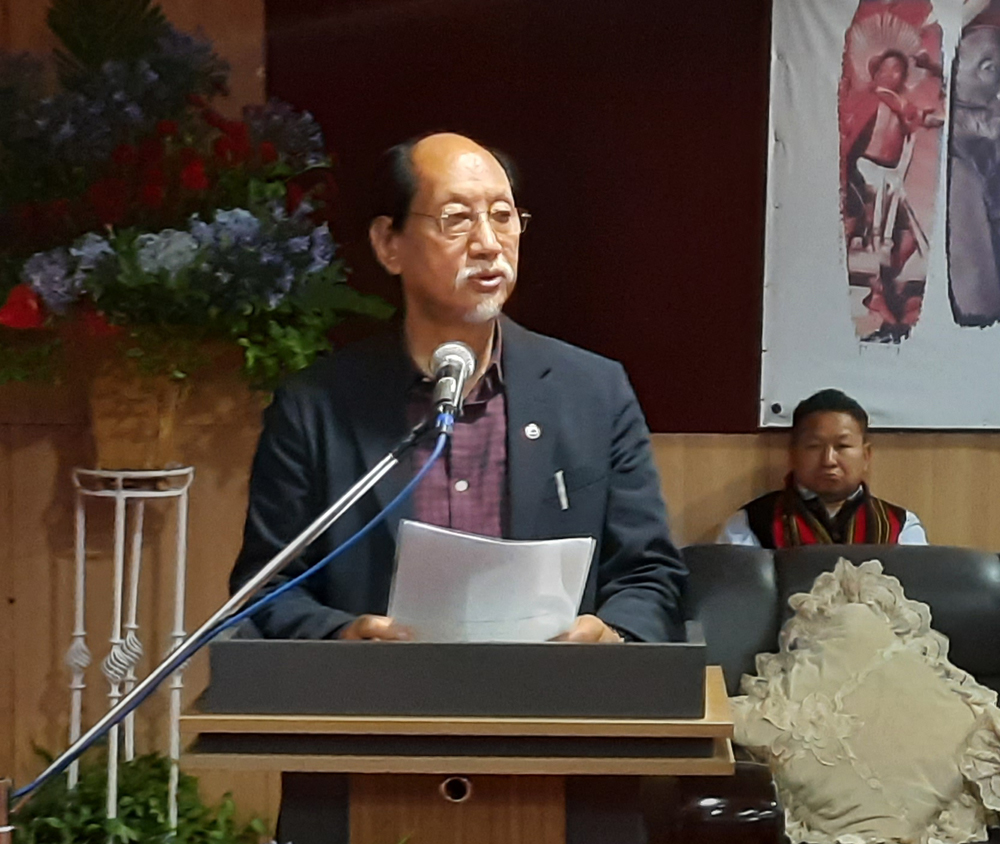THURSDAY, NOVEMBER 27, 2025
- Home
- Nagas have failed to prioritise important matters — Nagaland Chief Minister
Nagas have failed to prioritise important matters — Nagaland Chief Minister
Share

Our Correspondent
Kohima, May 23 (EMN): Nagaland Chief Minister Neiphiu Rio on Monday stressed on the need for documentation of rich Naga cultural heritage for posterity and guarding against cultural appropriation by others.
He was addressing the first state-level consultative meet with tribal hohos on documentation of traditional attires, motifs, designs, and ornaments at Capital Convention Centre in Kohima.
The CM said that Nagas still have a long way to go to become a civilised society despite the increase in literacy rate. He lamented scholars and researchers not delving enough into ‘the origin of Nagas- where we came from and how we became Nagas’.
‘Our roots are yet to be discovered. There is no written document with regard to our origin. It is only orally passed down through the generations’, he told the gathering.
The state government policy has always been to preserve and promote culture and traditions of the people, which is evident through organising of tribe festivals like mini-hornbill festivals and the Hornbill Festival, he said, adding ‘Nagas are so distinct that even the government of India has recognised the people through Article 371A’.
‘We must appreciate our forefathers for preserving our tradition and a special appreciation should go to women for their dedication and commitment to preserving them. Nagas have been quarreling over petty issues and are not able to prioritise important matters such as this,’ Rio said.
He suggested organising consultative meetings at the district level, saying that people might not be able to execute unless they understand the policies.
‘If Nagas want to be recognised, we should preserve our culture and tradition,’ he said, adding that outsiders do not come to see Nagas copycatting others ‘but to see our unique culture and tradition’.
On cultural appropriation
Emphasising on the need for documentation, Rio said: ‘Our food and our character (way of life) have to be patented so that it is not exploited by outsiders for commercial purposes.’
He said that of late, Nagas have been experiencing misrepresentation and incorrect usage of their traditional designs at fashion shows and on clothing sold in e-commerce websites without any regard for the people who hold their traditional symbols in high regard.
“This misuse of traditional attires and symbols, known as cultural appropriation, has to be guarded against. This issue of cultural appropriation should be taken in all sincerity because the unregulated use of our cultural designs and symbols will lead to distortion and misrepresentation,” he said.
“In fact, our traditional attires have so much symbolism attached to them that wearing them correctly and on appropriate occasions is also taken very seriously. It is not our intention that others should not use our traditional attire; nor should our communities and entrepreneurs be stopped from doing business in our traditional attire. However, the fact of the matter is that they have to be appropriately used,” he added.
To ensure that cultural heritage is not misused by others, he said measures like registering for Intellectual Property Rights (IPR) and Geographical Indications (GI), which have legal provisions.
“Only then can we start controlling and regulating the use of our traditional attires, symbols, and ornaments. Otherwise, a situation may arise where the ownership of our traditional and cultural heritage may be misutilised,” Rio said.
Presently, only Chakhesang community has obtained GI registration for their traditional attire (shawls). The Angami, Ao, and Sumi communities are also said to have taken steps for GI registration, he said, adding that the Department of Under Developed Areas (DUDA) has also started similar work for the tribal communities under its umbrella.
While assuring financial support to the committee that had been instituted for documentation of traditional attires, motifs, designs, and ornaments of all the tribes in Nagaland, he urged it to complete the work early and sought cooperation from all tribes.
Chairman of Nagaland Handloom and Handicrafts Development Corporation (NHHDC) Ltd., Miathou Krose is also the chairperson of the committee.
Patent Information Centre
The advisor for Information Technology and Communication, Science and Technology, and New and Renewable Energy, Mmhonlumo Kikon, said that there is a system in place to tackle the IPR theft. A Patent Information Centre (PIC) under the Nagaland Science and Technology Council (NASTEC) was established in 2011 to oversee IPR and GI-related activities in the state.
The PIC, which has been acting as the nodal agency, successfully facilitated the filing of GI for Chakhesang shawls in 2017. Although an achievement, Kikon expressed disappointment over failing to file GI for all the tribal shawls.
Government can only provide support and facilities to create institutions and systems to use; unless one comes forward and participates, it will not be able to preserve our cultural heritage, he pointed out.
‘Although the government is proactive in stopping the proliferation of intellectual property theft, unless we have our rights enshrined in the various systems that are available in the IPR, we will be allowing others to take advantage of our indigenous heritage,’ he added.
He challenged the gathering to be proactive and use the right system to preserve heritage as well as be vocal of cultural rights and heritage.
The committee for documentation of traditional attires, motifs, designs, and ornaments in the state is led by Miathou Krose as chairperson; managing director of NHHDC Ltd. Zakabo Rotoka as member-secretary; and six members namely Adela Moa, Art and Culture Director; Lithrongla Tongpi Rutsa, DUDA Director; I Sino Phom, Additional director & HOD, Tribal Affairs; Dzuvinuo Theunuo, IPR Additional Director; Sharon Longchari, Animal Husbandry and Veterinary Sciences Deputy Secretary; and Scientist D, PIC, NASTEC, Dr. Nesatalü Hiese.

